Abstract
Neurogenic bladder is a dysfunction of the lower urinary tract caused by nervous system disorder. We investigated the trends in publication of articles under the topic “neurogenic bladder” using bibliometric analysis. Articles on neurogenic bladder, published between 1995 and 2014, were retrieved from the ISI Web of Science citation database. We analyzed the search results for authors, countries, institutions, journals, and top-cited papers. A total of 1,904 articles were retrieved. There was a small increase in the number of articles on neurogenic bladder from 1995 (n = 43) to 2014 (n = 117). The USA was the leading country in the total number of articles (n = 598). However, the number of publications from China has rapidly increased, and China was ranked second in 2014. Emmanuel Chartier-Kastler (n = 65) was the most productive author, and University of Paris VI (Paris 6) (n = 61) was the most productive institution. The Journal of Urology published the greatest number of articles on this topic (n = 285). Articles on neurogenic bladder were often published in a professional journal under the category Urology & Nephrology, Neurosciences & Neurology, or Rehabilitation. Visualization analysis based on co-citation networks was conducted using CiteSpace III. Visualization analysis revealed that the hot spots in neurogenic bladder were botulinum toxin-A, prazosin, bethanechol, and afferent pathways. These findings provide new insight into the publication trends and hot spots in neurogenic bladder.
Keywords: nerve regeneration, neurogenic bladder, bibliometric analysis, Web of Science database, visualization analysis, CiteSpace III, citation analysis, neural regeneration
Introduction
Neurogenic bladder is any dysfunctional condition of the lower urinary tract caused by injury or disease of the nervous system, including spinal cord injury, Parkinson’s disease, and multiple sclerosis (Ginsberg, 2013). Neurogenic bladder is seen in 70–80% of spinal cord injury patients, 40–90% of multiple sclerosis patients, and 37–72% of Parkinson’s patients (Ginsberg, 2013). The symptoms of neurogenic bladder include detrusor muscle overactivity, sustained high bladder pressure, urinary incontinence and sphincter-detrusor dyssynergia (Stohrer et al., 2009; Manack et al., 2011). Neurogenic bladder can lead to many complications, creating a substantial burden for patients. The proportion of patients with neurogenic bladder who have lower urinary tract infection, obstructive uropathy and urinary retention are 29–36%, 6–11% and 9–14%, respectively (Manack et al., 2011). It remains a challenge for clinicians to comprehensively diagnose and evaluate bladder function, and provide appropriate individualized care (Ginsberg, 2013).
Bibliometric analysis is a scientific method for investigating publications on a given topic, and has been changing the research landscape (Bornmann and Leydesdorff, 2014). Since Eugene Garfield established the Science Citation Index (Garfield, 1964; Garfield, 1972), many bibliometric studies have analyzed scientific publications (Vioque et al., 2010; Jamshidi et al., 2013; Ahmad et al., 2014; Mao et al., 2014) in specific topics, including nerve research (Yang, 2012; Pan et al., 2013; Aleixandre-Benavent et al., 2014; Zhang et al., 2014).
Neurogenic bladder has been the subject of a variety of publications, including clinical guideline reports (Stohrer et al., 2009), clinical reviews (Klausner and Steers, 2011), and epidemiologic studies (Manack et al., 2011). However, the bibliometric profile of neurogenic bladder in the literature is still unknown. Therefore, in the present study, we conducted a bibliometric analysis on neurogenic bladder spanning a 20-year publication period (1995–2014). We analyzed the publications for author, year, country/region, journal, and most cited papers. In addition, we sought to identify the hot spots in neurogenic bladder.
Data and Methods
We used bibliometric analysis to study the profile of research articles on neurogenic bladder. We searched the Science Citation Index-Expanded (SCI-E) database through the Web of Science platform provided by Thomson Reuters. The SCI-E database is a widely accepted database comprising mostly high-quality scientific publications. Furthermore, The SCI-E database is based on citation relation among literature. Therefore, we can perform citation analysis rigorously. The search strategy was “Neurogenic Bladder” or “Bladder Neurogenesis” or “Neurogenic Urinary Bladder” as the topic. We limited the publication period to 20 years, 1995–2014. The search was performed on January 8, 2015. Original articles were further analyzed. The records extracted were analyzed for citation characteristics, top-cited authors, countries, funding, institutions, and journals. We also analyzed the publishing trends of the top 10 countries in this period. The base analysis was performed using Histcite 12.03.07 (http://www.histcite.com/). We also used CiteSpace v. 3.6 (Chen and Chen, 2005; Synnestvedt et al., 2005; Chen, 2006; Chen et al., 2012) to visualize the trends and patterns in neurogenic bladder.
Results
General data
A total of 2,434 publications on neurogenic bladder, published from 1995 to 2014, were retrieved from the Web of Science. Of these publications, 1,904 (78.22%) were original articles (Table 1). The number of articles increased slightly during the 20-year period, although there was a peak in 2007 (Figure 1). The total citations peaked in 2004 (Figure 1).
Table 1.
Number of articles and proportion of each publication type on neurogenic bladder between 1995 and 2014
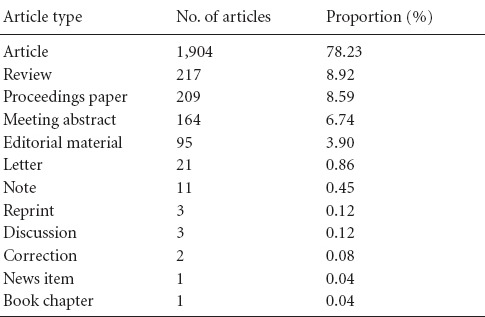
Figure 1.
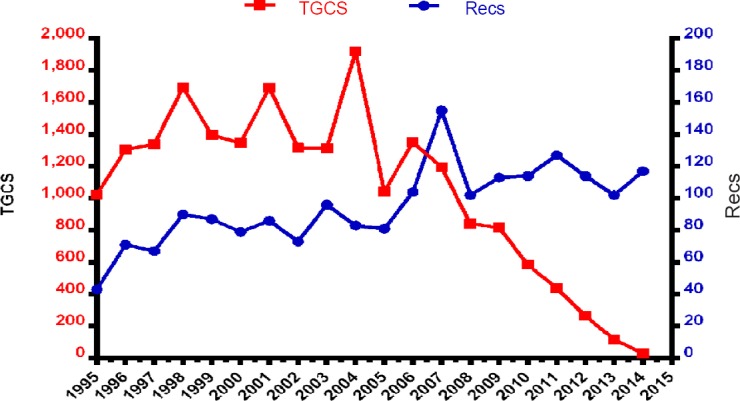
Number of published articles and citations on neurogenic bladder during 1995 to 2014.
Total Global Citation Score (TGCS) shows the total number of citations for a paper in the Web of Science. Number of Records (Recs) shows the number of records for a given item.
Profile of articles
Of 1,904 original articles, 1,539 (80.83%) were cited no less than once. The remaining 365 articles (19.17%) were not cited. The total number of citations was 21,034, and the average citations per article was 11.05. The primary language of published articles on neurogenic bladder was English (1,661 articles) (Table 2).
Table 2.
Top 10 languages in published original articles on neurogenic bladder between 1995 and 2014
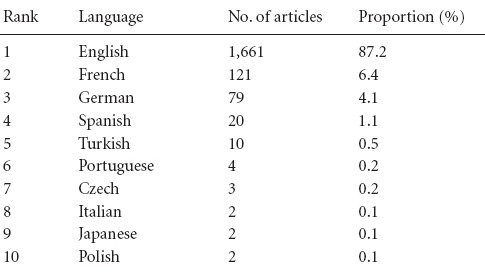
Countries
The authors were from 64 different countries or regions. The leading country in the total number of articles on this topic was the USA, followed by France, Germany, and Japan (Table 3). The USA was also the leading country in the annual number of publications from 1995 to 2014, except 2007, in which France produced the most articles. China had a moderate growth in the number of annually published papers, and was second only to the USA in 2014 (Figure 2).
Table 3.
Top 10 countries publishing articles on neurogenic bladder between 1995 and 2014
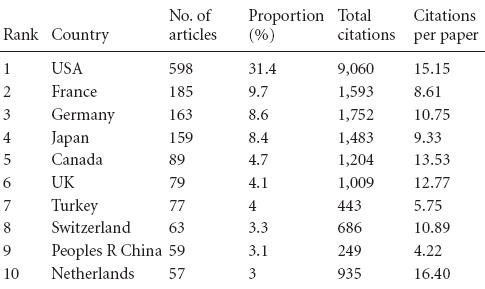
Figure 2.
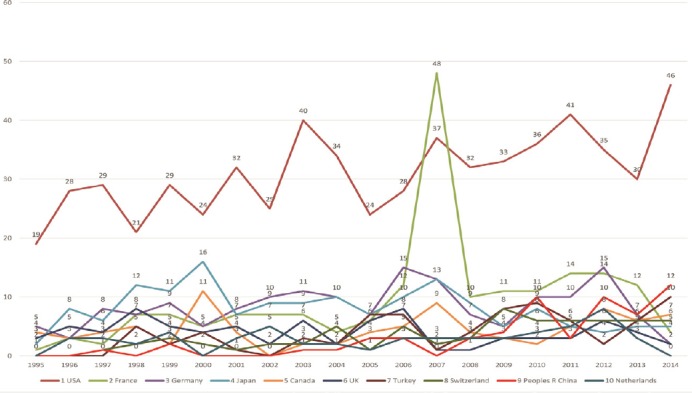
Trends in the publication of articles on neurogenic bladder by the top 10 productive countries from 1995 to 2014.
Authors
Emmanuel Chartier-Kastler, from France, was the first ranked author, with 65 articles (3.4%). Of the most prolific authors, five were from France, and two were from the USA (Table 4).
Table 4.
Top 10 authors publishing articles on neurogenic bladder between 1995 and 2014

Institutions
The first-ranking institution was University of Paris 6, with 61 published articles (3.2%). Moreover, French institutions occupied six of the top ten positions in the number of published articles on neurogenic bladder between 1995 and 2014. However, the University of Pittsburgh in the USA had the highest number of citations per paper at 29.00 (Table 5).
Table 5.
Top 10 institutions publishing articles on neurogenic bladder between 1995 and 2014

Journals
The articles were published in 429 different journals. We identified the top 15 journals having published more than 20 articles related to neurogenic bladder between 1995 and 2014. The first ranked journal, publishing the most articles, was The Journal of Urology (n = 285), followed by two other journals with more than 100 articles each, Neurourology and Urodynamics (n = 107) and Urology (n = 101). The Journal of Urology also had the greatest number of total citations (n = 5,575) followed by Urology (n = 1,831) and European Urology (n = 1,368). However, the journal with the greatest number of average citations per paper was European Urology (25.3 citations per paper), followed by The Journal of Urology (19.6) and Urology (18.1). Among the top 15 journals, 12 were in the Web of Science category Urology & Nephrology. Among the top 15 journals, four were quartile 1 journals, four were quartile 2 journals, five were quartile 3 journals, and three were quartile 4 journals according to subject category in Journal Citation Reports (JCR) (Table 6).
Table 6.
Top 15 journals publishing articles on neurogenic bladder between 1995 and 2014
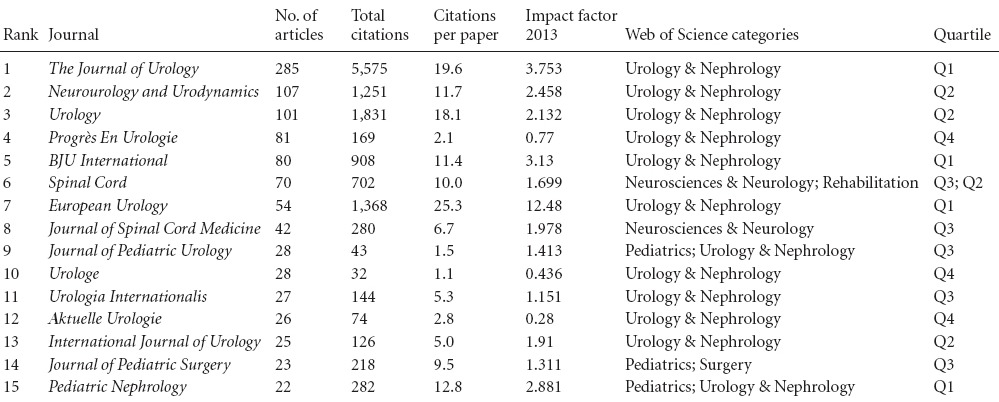
Hot papers
We list articles with more than 100 citations in Table 7. The 10 most cited articles were published between 1995 and 2014. The top ranking paper, with 377 citations, published in Journal of Neurotrauma, was on recovery from spinal cord injury (Anderson, 2004). The second ranking paper was published in Urology, and received 296 citations (de Groat, 1997).
Table 7.
Ten most-cited articles on neurogenic bladder between 1995 and 2014
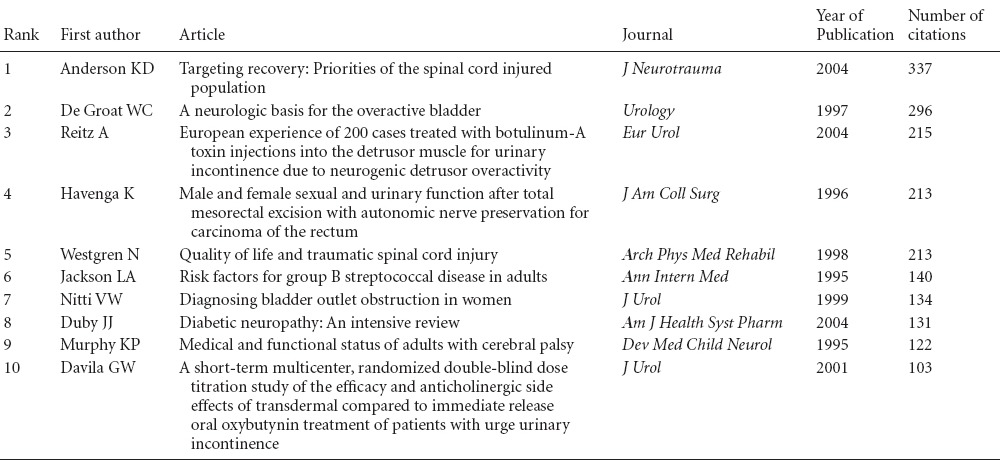
Visualization analysis
We conducted visualization analysis for co-cited burst terms in research articles retrieved from the Web of Science on neurogenic bladder, published between 1995 and 2014, using CiteSpace v. 3.6. The parameters in CiteSpace were as follows: timespan = 20 years (1995–2014); time slicing = 1; term type = burst terms; selection criteria (c, cc, ccv) = (4, 3, 20) (4, 4, 20) (4, 4, 20). The top 50 most cited or occurring items from each slice were selected. We used the Pathfinder network method to streamline the network, and mapped the visualization analysis. The network revealed 304 nodes and 612 lines. The articles with a centrality of more than 0.1 are presented in Table 8. The modularity Q was 0.7225, and the mean silhouette was 0.7516, with 22 co-citation clusters (Figure 3). We also present the time zone view for hot key words; the hot spots on neurogenic bladder were botulinum toxin-A, prazosin, bethanechol, afferent pathways, leukoencephalopathy, limb deficiency, motor neurons, transitional cell, nerve-terminals, pelvic floor dysfunction, and fecal incontinence (Figure 4).
Table 8.
Highly-cited (“classical”) publications (co-cited with most centrality) retrieved by CiteSpace visualization analysis
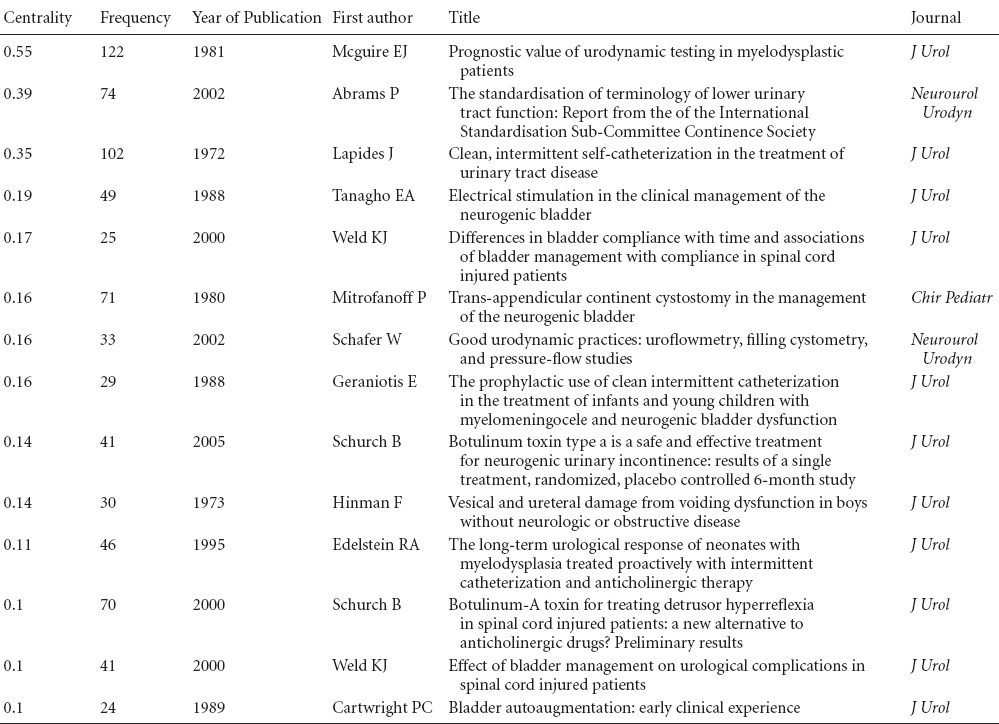
Figure 3.
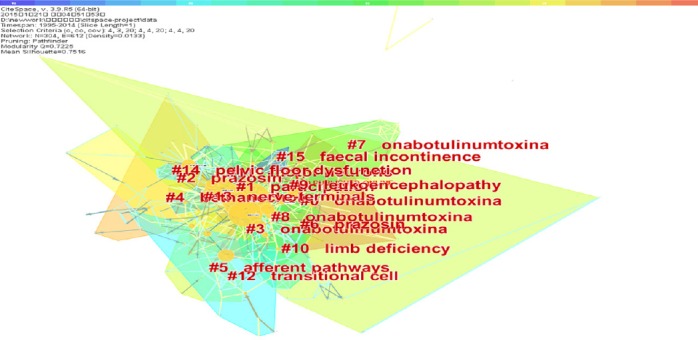
Visualization analysis for co-citation burst terms in research articles on neurogenic bladder between 1995 and 2014 retrieved from the Web of Science (analyzed using CiteSpace v. 3.6).
The figure shows the clustering and burst terms.
Figure 4.
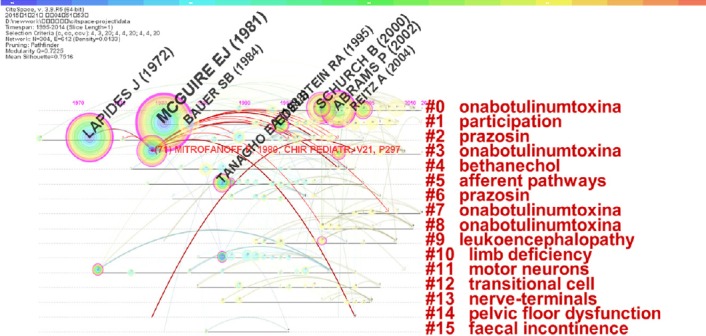
High-frequency key words in the timeline plot for publications on neurogenic bladder between 1995 and 2014 retrieved from the Web of Science (analyzed using CiteSpace v. 3.6).
The horizontal line shows the clusters. The circles represent the amount of literature. The curved line represents the relationships between the clusters.
Discussion
To the best of our knowledge, this is the first bibliometric analysis on the topic of neurogenic bladder. Our results show a mild increase in the number of publications worldwide on the topic of neurogenic bladder (Figure 1). The USA had the greatest number of published articles on neurogenic bladder. However, a growing research contribution of China has emerged. China ranked second only to the USA in 2014. This phenomenon was observed in other bibliometric analyses as well (Zhang et al., 2012; Mao et al., 2014; Yao et al., 2014). This analysis indicates that China is a major competitor for North America and Western Europe in publishing scientific research (Migaud, 2012). Previous studies have also shown that the scientific contribution of Mainland China has increased notably (Cheng and Zhang, 2010; Xu et al., 2011; Zhang et al., 2012; Ye et al., 2014). This phenomenon may be associated with government-initiated incentives (Franzoni et al., 2011). However, in terms of citations per paper, China ranked 10th among the top 10 countries publishing the most articles between 1995 and 2014. A reason for the low number of citations per paper from China may be that many of the papers were published later than those from other countries. However, the quality of research appears to be the major factor determining the number of citations.
The language of the publication may affect the number of citations. Articles in English have more opportunity to be acquired, read and cited, because most international journals are published in English and can be searched in open databases such as PubMed and Google scholar. Indeed, most papers from China were in English or Chinese, and this may have affected the number of citations received.
Among institutions, University of Paris 6 published more than two-thirds of the articles from France, and was the first-ranked institution, publishing the most articles on neurogenic bladder between 1995 and 2004. Furthermore, the first ranked author, Emmanuel Chartier-Kastler, was based at University of Paris 6. The third most cited article, “European experience of 200 cases treated with botulinum-A toxin injections into the detrusor muscle for urinary incontinence due to neurogenic detrusor overactivity” (Reitz et al., 2004), was also from the Chartier-Kastler laboratory. Thus, Chartier-Kastler and University Paris 6 were the leading author and institution, respectively, on this topic. The top 15 journals publishing articles on neurogenic bladder were all professional journals. Articles were in areas such as Urology & Nephrology, Neurosciences & Neurology, Rehabilitation, Pediatrics, and Surgery.
The top 10 cited articles were also analyzed to reveal the areas of great interest in neurogenic bladder. The most cited articles were focused on spinal cord injury (Westgren and Levi, 1998; Anderson, 2004), botulinum toxin (Reitz et al., 2004), etiology of neurogenic bladder (de Groat, 1997), carcinoma of the rectum (Havenga et al., 1996), streptococcal disease (Jackson et al., 1995), bladder outlet obstruction (Nitti et al., 1999), diabetic neuropathy (Duby et al., 2004), cerebral palsy (Murphy et al., 1995), and urge urinary incontinence (Davila et al., 2001). These highly cited papers help identify the major points of interest in research on neurogenic bladder.
We conducted visualization analysis using CiteSpace, based on co-citation theory (Li et al., 2014). The modularity Q (0.7225) and the mean silhouette (0.7516) revealed that the clustering result was acceptable. Using this visualization analysis, we were able to identify co-citation hot spots.
There are limitations to our study. We only searched the Web of Science; other literature databases were not searched. Therefore, we might not have been able to retrieve all papers on this topic, and selection bias may have been present.
Conclusion
The major findings of the present bibliometric study are as follows. (1) There has been a mild increase in the number of articles on neurogenic bladder over the last 20 years. (2) The USA was the leading country in the total number of articles; however, the number of papers from China has rapidly increased. (3) Emmanuel Chartier-Kastler and University of Paris 6 were the most productive author and institution, respectively, and articles on neurogenic bladder were often published in a professional journal in the subject category Urology & Nephrology, Neurosciences & Neurology or Rehabilitation. (4) The hot spots on neurogenic bladder were botulinum toxin-A, prazosin, bethanechol and afferent pathways. These results provide novel insight into the publication trends and hot spots on neurogenic bladder. Our findings may be useful for administrators managing neurogenic bladder research, as well as for researchers in planning and coordinating their own studies.
Footnotes
Conflicts of Interest: None declared.
Copyedited by Patel B, Raye W, Li CH, Song LP, Zhao M
References
- Ahmad SS, Evangelopoulos DS, Abbasian M, Roder C, Kohl S. The hundred most-cited publications in orthopaedic knee research. J Bone Joint Surg Am. 2014;96:e190. doi: 10.2106/JBJS.N.00029. [DOI] [PubMed] [Google Scholar]
- Aleixandre-Benavent R, Alonso-Arroyo A, Gonzalez de Dios J, Vidal-Infer A, Gonzalez-Munoz M, Sempere AP. Mult Scler. Houndmills, Basingstoke, England: 2014. Bibliometric profile of the global scientific research on multiple sclerosis (2003-2012) [DOI] [PubMed] [Google Scholar]
- Anderson KD. Targeting recovery: Priorities of the spinal cord-injured population. J Neurotrauma. 2004;21:1371–1383. doi: 10.1089/neu.2004.21.1371. [DOI] [PubMed] [Google Scholar]
- Bornmann L, Leydesdorff L. Scientometrics in a changing research landscape: Bibliometrics has become an integral part of research quality evaluation and has been changing the practice of research. EMBO Rep. 2014;15:1228–1232. doi: 10.15252/embr.201439608. [DOI] [PMC free article] [PubMed] [Google Scholar]
- Chen C, Chen Y. Searching for clinical evidence in CiteSpace. AMIA Annu Symp Proc 2005. 2005:121–125. [PMC free article] [PubMed] [Google Scholar]
- Chen C, Hu Z, Liu S, Tseng H. Emerging trends in regenerative medicine: a scientometric analysis in CiteSpace. Expert Opin Biol Ther. 2012;12:593–608. doi: 10.1517/14712598.2012.674507. [DOI] [PubMed] [Google Scholar]
- Chen CM. CiteSpace II: Detecting and visualizing emerging trends and transient patterns in scientific literature. J Am Soc Inf Sci Technol. 2006;57:359–377. [Google Scholar]
- Cheng T, Zhang X. Growing trend of China's contribution to the field of rheumatology 2000-2009: a survey of Chinese rheumatology research. J Rheumatol. 2010;37:2390–2394. doi: 10.3899/jrheum.100524. [DOI] [PubMed] [Google Scholar]
- Davila GW, Daugherty CA, Sanders SW. Transdermal Oxybutynin Study G (2001) A short-term multicenter, randomized double-blind dose titration study of the efficacy and anticholinergic side effects of transdermal compared to immediate release oral oxybutynin treatment of patients with urge urinary incontinence. J Urol. 166:140–145. [PubMed] [Google Scholar]
- de Groat WC. A neurologic basis for the overactive bladder. Urology. 1997;50:36–52. doi: 10.1016/s0090-4295(97)00587-6. [DOI] [PubMed] [Google Scholar]
- Duby JJ, Campbell RK, Setter SM, White JR, Rasmussen KA. Diabetic neuropathy: an intensive review. Am J Health-Syst Pharm. 2004;61:160–173. doi: 10.1093/ajhp/61.2.160. [DOI] [PubMed] [Google Scholar]
- Franzoni C, Scellato G, Stephan P. Science policy. Changing incentives to publish. Science. 2011;333:702–703. doi: 10.1126/science.1197286. [DOI] [PubMed] [Google Scholar]
- Garfield E. “Science Citation Index”--a new dimension in indexing. Science. 1964;144:649–654. doi: 10.1126/science.144.3619.649. [DOI] [PubMed] [Google Scholar]
- Garfield E. Citation analysis as a tool in journal evaluation. Science. 1972;178:471–479. doi: 10.1126/science.178.4060.471. [DOI] [PubMed] [Google Scholar]
- Ginsberg D. The epidemiology and pathophysiology of neurogenic bladder. Am J Manag Care. 2013;19:s191–196. [PubMed] [Google Scholar]
- Havenga K, Enker WE, McDermott K, Cohen AM, Minsky BD, Guillem J. Male and female sexual and urinary function after total mesorectal excision with autonomic nerve preservation for carcinoma of the rectum. J Am Coll Surg. 1996;182:495–502. [PubMed] [Google Scholar]
- Jackson LA, Hilsdon R, Farley MM, Harrison LH, Reingold AL, Plikaytis BD, Wenger JD, Schuchat A. Risk-factors for group B streptococcal disease in adults. Ann Intern Med. 1995;123:415–420. doi: 10.7326/0003-4819-123-6-199509150-00003. [DOI] [PubMed] [Google Scholar]
- Jamshidi AR, Gharibdoost F, Nadji A, Nikou M, Habibi G, Mardani A, Ghaemi M. Presentation of psoriatic arthritis in the literature: a twenty-year bibliometric evaluation. Rheumatol Int. 2013;33:361–367. doi: 10.1007/s00296-012-2428-y. [DOI] [PubMed] [Google Scholar]
- Klausner AP, Steers WD. The neurogenic bladder: an update with management strategies for primary care physicians. Med Clin N Am. 2011;95:111–120. doi: 10.1016/j.mcna.2010.08.027. [DOI] [PubMed] [Google Scholar]
- Li L, Hu J, Ho YS. Global performance and trend of QSAR/QSPR research: a bibliometric analysis. Mol Inform. 2014;33:655–668. doi: 10.1002/minf.201300180. [DOI] [PubMed] [Google Scholar]
- Manack A, Motsko SP, Haag-Molkenteller C, Dmochowski RR, Goehring EL, Jr, Nguyen-Khoa BA, Jones JK. Epidemiology and healthcare utilization of neurogenic bladder patients in a US claims database. Neurourol Urodyn. 2011;30:395–401. doi: 10.1002/nau.21003. [DOI] [PubMed] [Google Scholar]
- Mao Z, Wang GQ, Mei XF, Chen S, Liu XX, Zeng XT, Long AH, Zhang LC, Zhang LH, Tang PF. Systematic reviews on reports of hip fractures in Web of Science: a bibliometric analysis of publication activity. Chin Med J. 2014;127:2518–2522. [PubMed] [Google Scholar]
- Migaud H. Why publish a survey of orthopaedic scientific production from China? Orthop Traumatol Surg Res. 2012;98:251–252. doi: 10.1016/j.otsr.2012.02.001. [DOI] [PubMed] [Google Scholar]
- Murphy KP, Molnar GE, Lankasky K. Medical and functional status of adults with cerebral palsy. Dev Med Child Neurol. 1995;37:1075–1084. doi: 10.1111/j.1469-8749.1995.tb11968.x. [DOI] [PubMed] [Google Scholar]
- Nitti VW, Tu LM, Gitlin J. Diagnosing bladder outlet obstruction in women. J Urol. 1999;161:1535–1540. [PubMed] [Google Scholar]
- Pan Y, Zhang Y, Gao X, Jia J, Gao J, Ma Z. Scientific progress regarding neural regeneration in the Web of Science A 10-year bibliometric analysis(star) Neural Regen Res. 2013;8:3449–3454. doi: 10.3969/j.issn.1673-5374.2013.36.011. [DOI] [PMC free article] [PubMed] [Google Scholar]
- Reitz A, Stohrer M, Kramer G, Del Popolo G, Chartier-Kastler E, Pannek J, Burgdorfer H, Gocking K, Madersbacher H, Schumacher S, Richter R, von Tobel J, Schurch B. European experience of 200 cases treated with botulinum-A toxin injections into the detrusor muscle for urinary incontinence due to neurogenic detrusor overactivity. Eur Urol. 2004;45:510–515. doi: 10.1016/j.eururo.2003.12.004. [DOI] [PubMed] [Google Scholar]
- Stohrer M, Blok B, Castro-Diaz D, Chartier-Kastler E, Del Popolo G, Kramer G, Pannek J, Radziszewski P, Wyndaele JJ. EAU guidelines on neurogenic lower urinary tract dysfunction. Eur Urol. 2009;56:81–88. doi: 10.1016/j.eururo.2009.04.028. [DOI] [PubMed] [Google Scholar]
- Synnestvedt MB, Chen C, Holmes JH. CiteSpace II: visualization and knowledge discovery in bibliographic databases. AMIA Annu Symp Proc. 2005;2005:724–728. [PMC free article] [PubMed] [Google Scholar]
- Vioque J, Ramos JM, Navarrete-Munoz EM, Garcia-de-la-Hera M. A bibliometric study of scientific literature on obesity research in PubMed (1988-2007) Obes Rev. 2010;11:603–611. doi: 10.1111/j.1467-789X.2009.00647.x. [DOI] [PubMed] [Google Scholar]
- Westgren N, Levi R. Quality of life and traumatic spinal cord injury. Arch Phys Med Rehabil. 1998;79:1433–1439. doi: 10.1016/s0003-9993(98)90240-4. [DOI] [PubMed] [Google Scholar]
- Xu J, Mao ZG, Kong M, Hu LH, Ye CY, Xu CG, Rong S, Sun LJ, Wu J, Dai B, Chen DP, Zhu YX, Zhang YX, Zhang YQ, Zhao XZ, Mei CL. Scientific publications in nephrology and urology journals from Chinese authors in East Asia: a 10-year survey of the literature. PLoS One. 2011;6:e14781. doi: 10.1371/journal.pone.0014781. [DOI] [PMC free article] [PubMed] [Google Scholar]
- Yang X. Stem cell transplantation for treating Duchenne muscular dystrophy A Web of Science-based literature analysis. Neural Regen Res. 2012;7:1744–1751. doi: 10.3969/j.issn.1673-5374.2012.22.010. [DOI] [PMC free article] [PubMed] [Google Scholar]
- Yao Q, Chen K, Yao L, Lyu PH, Yang TA, Luo F, Chen SQ, He LY, Liu ZY. Scientometric trends and knowledge maps of global health systems research. Health Res Policy Syst. 2014;12:26. doi: 10.1186/1478-4505-12-26. [DOI] [PMC free article] [PubMed] [Google Scholar]
- Ye B, Du TT, Xie T, Ji JT, Zheng ZH, Liao Z, Hu LH, Li ZS. Scientific publications in respiratory journals from Chinese authors in various parts of North Asia: a 10-year survey of literature. BMJ Open. 2014;4:e004201. doi: 10.1136/bmjopen-2013-004201. [DOI] [PMC free article] [PubMed] [Google Scholar]
- Zhang KZ, Lv Z, Liu J, Zhu H, Li R. Restoration and protection of brachial plexus injury: hot topics in the last decade. Neural Regen Res. 2014;9:1723–1728. doi: 10.4103/1673-5374.141809. [DOI] [PMC free article] [PubMed] [Google Scholar]
- Zhang WJ, Zhang JL, Jiang H. Growing trend of China's contribution to the field of plastic and reconstructive surgery: a 10-year study of the literature. Ann Plast Surg. 2012;68:328–331. doi: 10.1097/SAP.0b013e318214e6dd. [DOI] [PubMed] [Google Scholar]


